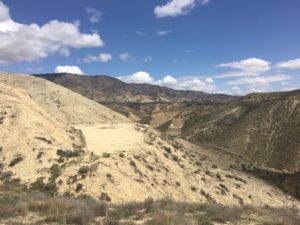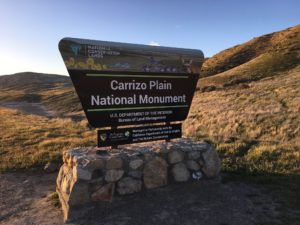
The proposed drilling site would be visible from several locations within the Caliente Mountain Wilderness Study Area.
SAN LUIS OBISPO, Calif.― Los Padres ForestWatch and the Center for Biological Diversity have appealed the Trump administration’s approval of a new oil well and pipeline in the Carrizo Plain National Monument. It is the first well the Interior Department has approved in the monument since it was established in 2001.
The appeals, filed with the Interior Board of Land Appeals in Virginia and the Bureau of Land Management’s California director, show that the oil well and pipeline would harm threatened and endangered wildlife and mar scenic views. The fossil fuel development would violate several laws, including the Endangered Species Act and National Environmental Policy Act, as well as the monument’s resource-management plan.
“Oil drilling in the Carrizo Plain National Monument must comply with the highest environmental standards to ensure the protection of this iconic landscape,” said ForestWatch Executive Director Jeff Kuyper. “This new well and pipeline fall far short of that standard, threatening the area’s rare wildlife and scenic views.”
The proposed well site is located at the base of the Caliente Mountains along the western boundary of Carrizo Plain National Monument. The area is home to several protected species, including the threatened San Joaquin antelope squirrel, the endangered San Joaquin kit fox, and a threatened flowering plant called the Kern mallow. Endangered California condors also visit this area with increasing frequency as the birds continue to expand into their historic range.
The oil well would be drilled on an existing oil pad that hasn’t produced oil since the 1950s. Two years ago the BLM approved the oil company’s request to formally abandon the pad and remove an old well, pipelines and other equipment from the site. The company also pledged to recontour and reseed the pad and a half-mile access road leading to it, restoring the area to natural conditions. The work was never done and now the BLM is backtracking on its abandonment plans by approving further development ther e.
The new well would be visible from key vantage points within Carrizo Plain National Monument, including the Caliente Wilderness Study Area on Caliente Mountain (the highest point in San Luis Obispo County), and from Highway 166, a scenic route in the Cuyama Valley.

It is the first well approved in the Carrizo Plain National Monument since it was established in 2001.
Existing oil leases were “grandfathered” in under the monument proclamation signed by President Bill Clinton in 2001, but must comply with more stringent standards. The new well would be drilled in the Russell Ranch Oil Field, which covers approximately 1,500 acres of the monument and adjacent private land. In 2016 the field produced only 125 barrels of oil per day ― 0.02 percent of the state’s total oil production and one of the lowest-producing oilfields in the state. The field is reportedly nearing the end of its useful life.
Conservation groups have asked the BLM to substantially revise its environmental assessment and consult with the U.S. Fish and Wildlife Service, but the BLM disregarded most of the concerns and refused to consult with the wildlife agency.
Carrizo Plain National Monument is a vast expanse of golden grasslands and stark ridges known for their springtime wildflower displays. Often referred to as “California’s Serengeti,” it is one of the last undeveloped remnants of the southern San Joaquin Valley ecosystem.
The Carrizo Plain is critical for the long-term conservation of this dwindling ecosystem, linking these lands to other high-value habitat areas like the Los Padres National Forest, Salinas Valley, Cuyama Valley and Bitter Creek National Wildlife Refuge in western Kern County. Honoring the area’s high biodiversity, limited human impacts, and rare geological and cultural features, the Carrizo Plain was declared a national monument in 2001. It includes more than 206,000 acres of public lands ― perhaps the largest native grassland remaining in all of California.







Comments are closed.